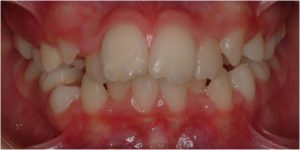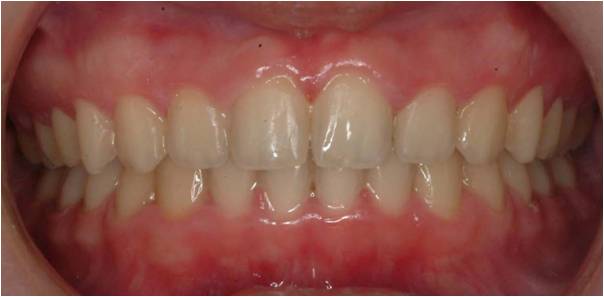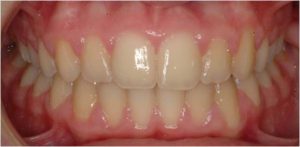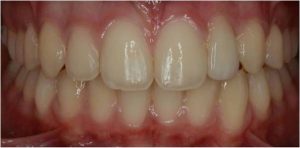During the initial examination, we will be able to inform you about the type and the severity of your orthodontic problem, to discuss alternative treatment options, treatment length and approximate cost. Together we can discuss any concerns and questions you have about your orthodontic treatment, so that leaving the office, you will have a good understanding about the process that will lead to your beautiful and healthy smile.

Crowding/crooked teeth
Spacing
Missing or supernumerary teeth
Impacted teeth
Crossbite
Deep bite
Upper jaw/upper teeth protrusion
Lower jaw protrusion
Open bite
Pre-restorative orthodontics
Midline deviation
Invisalign, the clear alternative to braces
Invisalign can treat various orthodontic problems without the use of wires or brackets, with the use of a series of clear aligners that are custom-made just for you. Your treatment is essentially invisible; hardly anyone will know that you are undergoing orthodontic treatment!
Invisalign aligners are designed to gradually move teeth towards their ideal final position based on the treatment plan that we prescribed for you. Every aligner is precisely fabricated to move your teeth mm by mm. The first step is to determine if Invisalign is right for you. If it is, then we determine your treatment plan and impressions of your teeth are sent to Align Technology. In the next appointment, we are able to view a 3D simulation of your treatment, even before it starts! Every aligner is used for about 2 weeks and is only taken out to eat and brush. To achieve the best possible results, only an Orthodontist, that has been trained and certified by Align Technology, can diagnose and treat with the Invisalign System.
For more information about Invisalign and how it works please visit www.Invisalign.eu

Incognito lingual braces
Lingual braces are fixed to the inner surface of the teeth (by the tongue and palate) and are therefore invisible! Incognito lingual braces are custom-made for each patient at a specialized orthodontic lab in Germany.
At your first visit to our practice, we’ll determine if Incognito system is right for you. Then, your dental impressions will be sent to Incognito lab in Bad Essen, Germany, where customized gold brackets and wires will be fabricated especially for you using a state-of-the-art process. That ensures maximum patient comfort and the best, predictable, reliable treatment results. Initial changes will occur and will be visible within a few weeks after Incognito placement. Your best smile is on the way!
For more information about Incognito and how it works please visit www.hiddenbraces.co.uk

Win lingual Braces
Win lingual braces like Incognito braces belong to the new generation lingual appliances and are also fixed to the inner surface of the teeth!
For more information about Win system and how it works please visit www.lingualsystems.co.uk.

Clear/invisible braces
These are made from ceramic material or synthetic sapphire crystals and offer a truly cosmetic alternative for adults and adolescents while maintaining the same effectiveness as metal braces. In combination with esthetic /white wires they are practically invisible.

Metal braces
They are the most common type of orthodontic appliances that are now much smaller in size and much more fun and colorful to wear.

Fixed palatal expander
Palatal expansion can markedly increase the width of the upper jaw, allowing for the upper and lower jaw and therefore, for the upper and lower teeth to fit together. Palatal expansion in some patients creates space for the permanent teeth, preventing therefore the need for extraction of permanent teeth. It also contributes to a broader, more attractive smile!
Headgear
The headgear is a type of appliance that creates special forces for guiding the growth of the face and jaws. It could also be used in order to move teeth into a better position or to prevent teeth from moving when they are not supposed to. It is a miraculous device that dramatically improves facial esthetics. The headgear is always used during night-time at home and is never worn outside the house.
Functional appliances
Functional appliances are being used in growing patients in order to guide growth potential and to therefore improve upper and lower jaw relationship and consequently facial esthetics.
Retainers
Keeping your smile beautiful is up to you! Maintaining the orthodontic result is an important part of your orthodontic treatment. In order to keep your beautiful and healthy smile you have to wear your orthodontic retainers according to the instructions given by the orthodontist.
Teeth continue to move throughout life, a natural phenomenon, since the bone around the teeth doesn’t stop to remodel. The best way to prevent tooth movement after orthodontic treatment is completed, is to wear retainers as instructed. If you notice significant change you have to notify our office. Retainers can be removable or fixed to the back of your teeth.
After the placement of the orthodontic appliances, maintaining a good oral hygiene requires more time and effort. This is very important in order to achieve optimal orthodontic results.
With oral hygiene we aim to remove dental plaque and food debris, which if otherwise left on the teeth can lead to gum problems (gingivitis, periodontitis), tooth decay, mouth odor or even permanent white lesions on the teeth that become apparent after the removal of the orthodontic appliances.
When to brush:
If you have orthodontic appliances brushing should be done after every meal and before you go to bed. If for some reason, you can’t brush immediately after a meal, rinse thoroughly with water, so that at least most food residues are washed away. At least once every day, brushing should be very meticulous, so that the teeth are spotlessly clean. This procedure takes more time, so it is ideal to be performed just before bedtime.
How to brush:
Use fluoride toothpaste and a toothbrush that is in good condition. When you have orthodontic appliances, the toothbrush wears out quickly, so you have to make sure you replace it, after the first signs of wear.
Brush around all the parts of the orthodontic appliances using circular movements spending 10 seconds on every tooth. Make sure that the tooth surfaces that are close to your gums are perfectly clean. These are the surfaces where cavities form most of the time. Brushing should take at least 3 minutes. Do not forget to brush the backsides of your teeth, your gums and tongue. The use of an electric toothbrush is strongly recommended.

Interproximal brush:
An interproximal brush can help significantly in maintaining good oral hygiene since it can slip under the archwire to completely remove plaque and food particles that are stuck around orthodontic appliances. Since they come with a lid you can always carry them with you and use them after each meal.
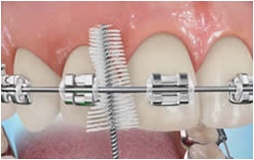
Orthodontic appliances are strong in order to move teeth but are very sensitive in case they are being abused. Therefore, you should not forget to take care of them and you should not mistreat them.
You have to be very careful about the kind of foods you eat and the way you eat them.
Foods to avoid:
- Hard food (pop corn, nuts, hard bread and pizza crust) that can cause damage to your braces, make them loose or deform the archwire. You can always eat apples, carrots, meat and other hard food of that kind, as long as you cut it in small pieces before you eat it and not bite on it directly.
- Sticky food (caramels, toffee, chewing gum) that can get your braces to become loose.
- Sugary Food (candy, chocolate, soda), that can cause cavities. After you consume sugary food you have to either brush or rinse your mouth with water.
You also have to avoid biting on hard things, like pens, pencils, ice or ….your nails!!!
There are very few true emergencies that you might encounter during your orthodontic treatment that will need immediate help from an orthodontist. The most common ones can be easily remedied by you or your family at home or can wait until the next orthodontic appointment. If however a problem comes up that you cannot resolve on your own, do not hesitate to call us, so that we can set up a repair appointment.
The most common problems are:
Sore teeth
It is normal and it is anticipated that teeth are sore for 2-3 days after each orthodontic appointment. Soreness is usually more intense during meals. If your teeth are very sore, stick on a soft diet and rinse with warm salt water. If soreness persists you may take any non-aspirin pain reliever.
Cheek irritation when wire is sticking out
Try to put the wire back into place. If the wire does not move, dry it with a tissue and cover it with orthodontic sticky wax or try to cut it with nail clippers that have been previously disinfected with alcohol.

If a band or bracket comes loose or a wire
If it causes cheek or tongue irritation, try to cover it with orthodontic sticky wax. Call the office to schedule a repair appointment. If it comes loose completely, bring it with you on your next appointment.
Bleeding during brushing
Generalized or localized bleeding during brushing is a sign of gum inflammation because of poor oral hygiene. Therefore, all you need to do is brush more thoroughly in the area that is bleeding and use a mouth rinse that we will prescribe to you.
Cheek or lip irritation
During the first days after the placement of orthodontic appliances, you might encounter irritation or small sore spots inside your mouth, on the cheeks, lips or tongue, due to contact and rubbing with the orthodontic appliance.
The irritation is temporary and disappears a few days later when the tissues adjust to the new situation. The orthodontic relief wax that we supply can assist you to relief the irritation when you place a small amount on top of the bracket or wire that causes the irritation.
It is important that you are able to recognize the various types of orthodontic appliances, so that we can communicate efficiently if a problem arises.

Ligatures (A)
The wire is fixed to every bracket with an elastic (colored or clear) or metal ligature.
Wire (B)
The wire is fixed to the brackets with ligatures and is capable of applying forces to the teeth in order to achieve orthodontic movement.
Brackets (C)
Brackets are bonded directly on the teeth and are used to keep the wire in place.
Metal Bands (D)
Metal bands are placed on the posterior (back) teeth.
Hooks for rubber bands (E)
These are hooks on which the patient places rubber bands in order to guide tooth movement.




